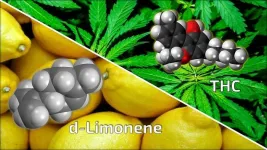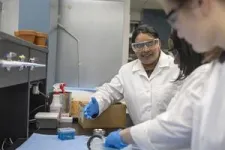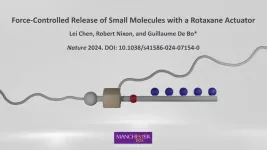(Press-News.org) FOR IMMEDIATE RELEASE
A Johns Hopkins Medicine-led research team has added to evidence that a chemical found naturally in cannabis (also known as marijuana) can — in the right amounts — lessen the anxiety-inducing effects of tetrahydrocannabinol (THC), the primary psychoactive sister chemical found in cannabis. The finding has the potential to advance the medicinal use of THC, and reduce the risks of its recreational use in some people.
The substance, called d-limonene, is one of the most abundant terpenes, or essential oils, in the cannabis plant, and has shown promise in rodent studies in reducing anxiety behaviors. However, there has been little research on d-limonene or other terpenes in humans. As a group, terpenes are responsible for the taste, aroma and color of plants.
In a recent study, first published online April 1 in the Journal of Drug and Alcohol Dependence, investigators tested the effects of vaporized d-limonene alone and mixed with THC to examine the anxiety-reducing effects in humans. They found the addition of d-limonene significantly reduced overall ratings of feeling “anxious/nervous” and “paranoid” compared with rating the effect of THC alone.
As cannabis legalization becomes more prevalent, its use for both medicinal and non-medicinal purposes is expanding rapidly. In recent years, selective breeding of cannabis plants has resulted in strains that contain upwards of 20% – 30% THC, compared with an average of 12% a decade ago. This may make it more difficult for users to be consistent with the amount of THC they consume on a given occasion.
THC interacts with receptors in the brain to produce feelings of relaxation and euphoria. However, researchers say that when a user is exposed to higher-than-usual doses of THC, the drug can also trigger anxiety, fear and panic.
“People use cannabis to help reduce anxiety, depression and post-traumatic stress disorder, but since THC levels vary widely, if a person overshoots their tolerance of THC, cannabis can induce anxiety rather than relieve it,” says study senior author Ryan Vandrey, Ph.D., professor of psychiatry and behavioral sciences at the Johns Hopkins University School of Medicine. “Our study demonstrates that d-limonene can modulate the effects of THC in a meaningful way and make THC more tolerable to people using it for both therapeutic and non-therapeutic purposes.”
In the study, 20 healthy adults with a median age of 26 participated in up to 10 outpatient sessions, during which they inhaled vaporized d-limonene alone, vaporized THC alone, vaporized THC and d-limonene together, or vaporized distilled water (as a placebo).
The study was double-blinded, meaning neither the researchers nor participants knew who was receiving which mixture. Twenty participants completed nine test sessions, while 12 participants also took part in an optional tenth session of THC combined with a triple-dose (15 milligrams) of d-limonene to test the extreme extent of the essential oil’s dose response curve. This was conducted after appropriate safety data were obtained from the lower doses (1 milligram and 5 milligrams).
In all participants, the researchers measured subjective drug effects, subjective ratings of mood, vital signs (heart rate and blood pressure) and cognitive performance (measures of memory, psychomotor ability and attention) at baseline, and then an additional nine times after initial exposure over the course of each of the six-hour test sessions. They also collected blood and urine samples from each subject before, during and after each six-hour session to test for THC and d-limonene levels.
The research team concluded that combining d-limonene with THC significantly reduced subjective indicators/reports of THC-induced anxiety in participants. These reductions were greater as the dose of d-limonene was increased.
Additionally, they saw no interference with THC’s subjective, cognitive or physiological effects when co-administered with d-limonene, as well as no effects from d-limonene alone that differed from the placebo test.
“This study is a first step in uncovering how we can mitigate risks of THC when used in medicine, and also is targeted at making cannabis safer for the general, non-therapeutic consumer,” says study lead author Tory Spindle, Ph.D., associate professor of psychiatry and behavioral sciences at the Johns Hopkins University School of Medicine.
The researchers plan to continue experimenting with other terpenes alone and in combination with THC to see how they interact with each other, as well as replicate the d-limonene study in larger and more diverse clinical populations. They also plan to test alternative methods of administration, such as oral ingestion.
Along with Vandrey and Spindle, members of the study team from Johns Hopkins Medicine are George Bigelow, Lauren Pollak and C. Austin Zamarippa. Other team members are Ethan Russo at CReDO Science, and Uwe Christians, Jost Klawitter, Cristina Sempio, Touraj Shokati, Bridget Tompson and Alexandra Ward at the University of Colorado Anschutz Medical Campus.
Spindle has served as a consultant for Canopy Health Innovations Inc. and has received research funding from Cultivate Biologics. Vandrey has served as a consultant or received honoraria from Mira1a Therapeutics Inc., Jazz Pharmaceuticals, Charlotte’s Web, Syqe Medical Ltd. and WebMD. Russo is the founder and CEO of CReDo Science and a scientific adviser to True Terpenes.
A patent application (PCT/US2022/014296) has been submitted by The Johns Hopkins University on behalf of Vandrey, Spindle and Russo for the use of d-limonene to reduce THC-induced anxiety, based on the data presented in this study (after the trial concluded and data were analyzed).
The other study authors do not have financial or conflict-of-interest disclosures.
END
Researchers show chemical found naturally in cannabis may reduce anxiety-inducing effects of THC
Study finds an essential oil, d-limonene, significantly reduces feelings of anxiety and panic, without altering the desired effects of marijuana’s active ingredient
2024-04-10
ELSE PRESS RELEASES FROM THIS DATE:
AI-powered ‘sonar’ on smartglasses tracks gaze, facial expressions
2024-04-10
ITHACA, N.Y. – Cornell University researchers have developed two technologies that track a person’s gaze and facial expressions through sonar-like sensing. The technology is small enough to fit on commercial smartglasses or virtual reality or augmented reality headsets, yet consumes significantly less power than similar tools using cameras.
Both use speakers and microphones mounted on an eyeglass frame to bounce inaudible soundwaves off the face and pick up reflected signals caused by face and eye movements. ...
Newly found genetic variant defends against Alzheimer’s disease
2024-04-10
NEW YORK, NY (April 10, 2024)--Columbia researchers have discovered a genetic variant that reduces the odds of developing Alzheimer’s disease by up to 70% and may be protecting thousands of people in the United States from the disease.
The discovery of the protective variant, which appears to allow toxic forms of amyloid out of the brain and through the blood-brain barrier, supports emerging evidence that the brain’s blood vessels play a large role in Alzheimer's disease and could herald a new direction in therapeutic development.
“Alzheimer’s disease may get started with amyloid deposits in the brain, but ...
Serious flu damage prevented by compound that blocks unnecessary cell death
2024-04-10
As lung cells are killed by the influenza virus, they burst open, releasing molecular signals that trigger the immune cells that can combat the infection. This strategy can be an important red flag that something is wrong; however, if one cell death response, called necroptosis, continues unchecked, it can cause life-threatening injury to lung tissue. In a study published April 10 in the journal Nature, Tufts University School of Medicine scientists and collaborators present a newly developed compound ...
CHOP, Stanford researchers identify protein that controls CAR T cell longevity
2024-04-10
Philadelphia, April 10, 2024 – CAR T cell therapy has revolutionized the way certain types of cancer are treated, and the longer those CAR T cells live in a patient’s body, the more effectively they respond to cancer. Now, in a new study, researchers at Children’s Hospital of Philadelphia (CHOP) and Stanford Medicine have found that a protein called FOXO1 improves the survival and function of CAR T cells, which may lead to more effective CAR T cell therapies and could potentially expand its use in difficult-to-treat cancers. The findings were published online today by the journal Nature.
T ...
Race, ethnicity, and delayed time to COVID-19 testing among health care workers
2024-04-10
About The Study: In this cross-sectional study of health care personnel (HCP), compared with non-Hispanic white HCP and clinical HCP with graduate degrees, non-Hispanic Black HCP, non-Hispanic HCP of other races, and HCP of all other professional and education backgrounds were more likely to have delayed COVID-19 testing. These findings suggest that time to testing may serve as a valuable metric in evaluating sociodemographic disparities in the response to COVID-19 and future health mitigation strategies.
Authors: DaMarcus ...
Trends in deaths of despair by race and ethnicity
2024-04-10
About The Study: As of 2022, the midlife mortality rates from deaths of despair (deaths from suicide, drug overdose, and alcoholic liver disease) among Black individuals were higher than rates among white individuals, and rates among American Indian or Alaska Native individuals remained higher than rates in the other groups. Rising inequalities in deaths of despair among American Indian or Alaska Native and Black individuals were largely attributable to disproportionate early mortality from drug- and alcohol-related causes, which increased leading up to and during the COVID-19 pandemic.
Authors: Joseph ...
Revolutionary molecular device unleashes potential for targeted drug delivery and self-healing materials
2024-04-10
In a new breakthrough that could revolutionise medical and material engineering, scientists have developed a first-of-its-kind molecular device that controls the release of multiple small molecules using force.
The researchers from The University of Manchester describe a force-controlled release system that harnesses natural forces to trigger targeted release of molecules, which could significantly advance medical treatment and smart materials.
The discovery, published today in the journal Nature, uses a novel technique using a type of interlocked molecule known as rotaxane. Under the influence of mechanical force - such ...
The genesis of our cellular skeleton, image by image
2024-04-10
Cells contain various specialised structures - such as the nucleus, mitochondria or peroxisomes - known as “organelles’’. Tracing their genesis and determining their structure is fundamental to understanding cell function and the pathologies linked to their dysfunction. Scientists at the University of Geneva (UNIGE) have combined high resolution microscopy and kinematic reconstruction techniques to visualise, in motion, the genesis of the human centriole. This organelle, essential to the organisation of the cell skeleton, is associated - in case of dysfunction - with certain cancers, brain disorders or retinal diseases. This work, published in the journal Cell, elucidates ...
Quantum breakthrough when light makes materials magnetic
2024-04-10
The potential of quantum technology is huge but is today largely limited to the extremely cold environments of laboratories. Now, researchers at Stockholm University, at the Nordic Institute for Theoretical Physics and at the Ca’ Foscari University of Venice have succeeded in demonstrating for the very first time how laser light can induce quantum behavior at room temperature – and make non-magnetic materials magnetic. The breakthrough is expected to pave the way for faster and more energy-efficient computers, information transfer and data storage.
Within a few decades, the advancement of quantum technology ...
Living near green space associated with fewer emotional problems in preschool-age kids, NIH study finds
2024-04-10
Children who live in areas with natural spaces (e.g., forests, parks, backyards) from birth may experience fewer emotional issues between the ages of 2 and 5, according to a study funded by the NIH Environmental Influences on Child Health Outcomes (ECHO) program.
While research has suggested that time in nature is important for mental health, studies examining the effects on young children are limited. ECHO investigators addressed this research gap by analyzing information from parents about the behavior of their children from ages 2 to 11. They combined this data with the family’s ...
LAST 30 PRESS RELEASES:
The (metabolic) cost of life
CFRI special issue call for papers: New Frontiers in Sustainable Finance
HKU Engineering scholar demonstrates the smallest all-printed infrared photodetectors to date
Precision empowerment for brain "eavesdropping": CAS team develops triple-electrode integrated functional electrode for simultaneous monitoring of neural signals and chemical transmitters during sleep
Single-capillary endothelial dysfunction resolved by optoacoustic mesoscopy
HKU three research projects named among ‘Top 10 Innovation & Technology News in Hong Kong 2025’ showcasing excellence in research and technology transfer
NLRSeek: A reannotation-based pipeline for mining missing NLR genes in sequenced genomes
A strand and whole genome duplication–aware collinear gene identification tool
Light storage in light cages: A revolutionary approach to on-chip quantum memories
Point spread function decoupling in computational fluorescence microscopy
BacPhase: Long-insert paired-end sequencing for bin marker construction and genome phasing
GmWOX1 regulates the mediolateral polarity of compound leaves in soybean
ChargeFabrica: An open-source simulation tool that aims to accelerate search for high performance perovskite solar cells
High levels of ADAR overexpression induce abundant and stochastic off-target RNA editing in rice protoplasts
On-demand upgraded recycling of polyethylene and construction of sustainable multifunctional materials based on the "LEGO" strategy
New "Stomata in-sight" system allows scientists to watch plants breathe in real-time
Anorexia nervosa may result in long-term skeletal muscle impairment
Narrative-based performance reviews deemed fairest by employees
New insights reveal how advanced oxidation can tackle emerging water pollutants
New review shows how biomass can deliver low-carbon gaseous fuels at scale
Climate change is quietly rewriting the world’s nitrogen cycle, with high stakes for food and the environment
Study finds SGLT-2 inhibitors linked to lower risk of diabetic foot nerve damage
Microbes may hold the key to brain evolution
Study examines how the last two respiratory pandemics rapidly spread through cities
Gender stereotypes reflect the division of labor between women and men across nations
Orthopedics can play critical role in identifying intimate partner violence
Worms as particle sweepers
Second spider-parasitic mite described in Brazil
January 2026 issues of APA journals feature new research on autism, pediatric anxiety, psychedelic therapy, suicide prevention and more
Private equity acquired more than 500 autism centers over the past decade, new study shows
[Press-News.org] Researchers show chemical found naturally in cannabis may reduce anxiety-inducing effects of THCStudy finds an essential oil, d-limonene, significantly reduces feelings of anxiety and panic, without altering the desired effects of marijuana’s active ingredient







